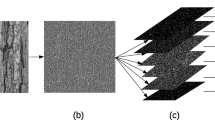Abstract
Three aspects of texture are distinguished by fractal geometry: Fractal Dimension (FD), Lacunarity and Succolarity. Although, FD has been well studied and Lacunarity has been more and more used, Succolarity, until now, has not been considered. This work presents a method to compute Succolarity. The proposed approach, for this computation, is based on the evaluation of a proposed equation that employ the FD Box Counting idea adapted to the concept of Succolarity. Simple examples, on 2D and 3D images, are considered to easily explain, step by step, how to compute the Succolarity. To illustrate this approach examples are shown, they range form satellite to ultrasound images. The proposed form of Succolarity evaluation is a unique feature usable whether it is relevant differentiate images with some directional or flow information associated with it. Therefore it could be used as a new feature in pattern recognition processes for the identification of natural textures. Furthermore, it works very well when is relevant differentiate images with some characteristics (e.g. directional information) that can not be discriminate by FD or Lacunarity.
Similar content being viewed by others
Explore related subjects
Discover the latest articles, news and stories from top researchers in related subjects.References
Mandelbrot, B. B. (1977). Fractal geometry of nature. New York: Freeman.
Melo, R. H. C. (2007). Using fractal characteristics such as fractal dimension, Lacunarity and Succolarity to characterize texture patterns on images. Master’s thesis, Federal Fluminense University. Link: http://www.ic.uff.br/~rmelo/msc_thesis.htm.
Melo, R. H. C., Vieira, E. A., & Conci, A. (2006). Comparing two approaches to compute Lacunarity of mammograms. In Proceedings of the IEEE signal processing society 13th international conference on systems, signal and image processing and semantic multimodal analysis of digital media (IWSSIP 2006), Budapest, Hungary (pp. 299–302).
Melo, R. H. C., Vieira, E. A., & Conci, A. (2006). Characterizing the Lacunarity of objects and image sets and its use as a technique for the analysis of textural patterns. In J. Blanc-Talon, et al. (Eds.), LNCS: Vol. 4179. Advanced concepts for intelligent vision systems (pp. 208–219). Berlin: Springer.
Sarkar, N., & Chaudhuri, B. B. (1992). An efficient approach to estimate Fractal Dimension of textural images. Pattern Recognition, 25, 1035–1041.
Block, A., von Bloh, W., & Schellnhuber, H. J. (1990). Efficient box-counting determination of generalized Fractal Dimensions. Physical Review. A, 42, 1869–1874.
Barabási, A. L., & Stanley, H. E. (1995). Fractal concepts in surface growth. New York: Cambridge University Press.
Conci, A., & Monteiro, L. H. (2000). Multifractal characterization of texture-based segmentation. In ICIP 2000, Vancouver, Canada (pp. 792–795).
Conci, A., & Proença, C. B. (1998). In Computer networks and ISDN Systems, pages: Vol. 30. A fractal image analysis system for fabric inspection based on a box-counting method (pp. 1887–1895). Amsterdam: Elsevier.
Mandelbrot, B. B., & Van Ness, J. (1968). Fractional Brownian motion, fractional noise and applications. SIAM Review, 10, 422–437.
Barros Filho, M. N. M., & Sobreira, F. A. (2005). Assessing texture pattern in slums across scales: an unsupervised approach. CASA working paper, Centre for Advanced Spatial Analysis, CASA Seminar, University College London, London, 87. Link: http://www.casa.ucl.ac.uk/working_papers/paper87.pdf.
Barros Filho, M. N. M., & Sobreira, F. A. (2005). Analysing spatial patterns in slums: a multiscale approach. Congresso Internacional de Planejamento Urbano Regional Integrado e Sustentável, São Carlos (SP). São Carlos: PLURIS.
Melo, R. H. C., & Conci, A. (2008). Succolarity: defining a method to calculate this fractal measure. In 15th international conference systems, signals and image processing, 2008. IWSSIP 2008, Bratislava, Slovak Republic (pp. 291–294).
Size, G. P., & Duncan, R. K. (2006). Vascular-web. Link: http://www.vascular-web.com, 2006.
Batty, M., & Longley, P. (1994). Fractal cities: geometry of form and function (1st ed.). London: Academic Press.
Frankhauser, P. (1997). Fractal analysis of urban structures. In E. Holm (Ed.), Modelling space and networks: progress in theoretical and quantitative geography (pp. 145–181). Umea: Gerum Kulturgeografi.
Sobreira, F., & Gomes, M. (2001). The geometry of slums: boundaries, packing and diversity. Working paper series, CASA—Centre for Advanced Spatial Analysis—University College London, London, 30. Link: http://www.casa.ucl.ac.uk/working_papers/paper30.pdf.
Space Imaging Brazil (2004). Link: http://www.spaceimaging.com.br/.
Barros Filho, M. N. M., & Sobreira, F. J. A. (2008). Accuracy of Lacunarity algorithms in texture classification of high spatial resolution images from urban areas. In XXI congress of international society of photogrammetry and remote sensing, 2008, Beijing, China. XXI congress of international society of photogrammetry and remote sensing, Beijing, China.
Valous, N. A., Mendoza, F., Sun, D.-W., & Allen, P. (2009). Texture appearance characterization of pre-sliced pork ham images using fractal metrics: Fourier analysis dimension and Lacunarity. Food Research International, 42(3), 353–362.
Frankhauser, P. (2008). Fractal geometry for measuring and modelling urban patterns. In S. Albeverio, D. Andrey, P. Giordano, & A. Vancheri (Eds.), The dynamics of complex urban systems—an interdisciplinary approach (pp. 241–243). Berlin: Springer.
Tannier, C., & Pumain, D. (2005). Fractals in urban geography: a theoretical outline and an empirical example, Cybergeo. European Journal of Geography, 307, 20 http://www.cybergeo.eu/index3275.html, 22 pp.
Author information
Authors and Affiliations
Corresponding author
Rights and permissions
About this article
Cite this article
de Melo, R.H.C., Conci, A. How Succolarity could be used as another fractal measure in image analysis. Telecommun Syst 52, 1643–1655 (2013). https://doi.org/10.1007/s11235-011-9657-3
Published:
Issue Date:
DOI: https://doi.org/10.1007/s11235-011-9657-3




